Tuning the Biological Activity of Camphorimine Complexes through Metal Selection
Abstract
:1. Introduction
2. Results
2.1. Biological Studies
2.1.1. Cytotoxic Activity
2.1.2. Complex Stability in Solution
2.1.3. Complex–DNA Interaction
2.1.4. Production of ROS
2.1.5. Membrane Lipid Peroxidation
2.1.6. Caspase-3/7 Activation
2.1.7. Complex Cellular Uptake
2.2. Toxicity Assessment of [Ag(NO3)(1A)] (5) Using the In Vivo Model C. elegans
3. Discussion
4. Materials and Methods
4.1. Synthesis
4.2. Biological Assays
4.2.1. Complex Cytotoxicity Activity
4.2.2. Detection of ROS by H2DCF-DA
4.2.3. Generation of Superoxide Radicals (NBT Assay)
4.2.4. Lipid Peroxidation (MDA) Assay
4.2.5. Complex Interaction with DNA
4.2.6. Apoptosis (Caspase-3/7 Assay)
4.2.7. Complexes Cellular Uptake
4.2.8. Imaging Copper and Gold Distribution in Cells
4.2.9. In Vivo Studies Using the Nematode Caenorhabditis elegans
5. Conclusions
Supplementary Materials
Author Contributions
Funding
Institutional Review Board Statement
Informed Consent Statement
Data Availability Statement
Acknowledgments
Conflicts of Interest
References
- Thun, M.J.; DeLancey, J.O.; Center, M.M.; Jemal, A.; Ward, E.M. The global burden of cancer: Priorities for prevention. Carcinogenesis 2010, 31, 100–110. [Google Scholar] [CrossRef] [PubMed] [Green Version]
- Tannock, I.F. Conventional cancer therapy: Promise broken or promise delayed. Lancet 1998, 351, 9–16. [Google Scholar] [CrossRef]
- Arruebo, M.; Vilaboa, N.; Sáez-Gutierrez, B.; Lambea, J.; Tres, A.; Valladares, M.; González-Fernández, A. Assessment of the Evolution of Cancer Treatment Therapies. Cancers 2011, 3, 3279–3330. [Google Scholar] [CrossRef] [Green Version]
- Lazarević, T.; Rilak, A.; Bugarčić, Ž.D. Platinum, palladium, gold and ruthenium complexes as anticancer agents: Current clinical uses, cytotoxicity studies and future perspectives. Eur. J. Med. Chem. 2017, 142, 8–31. [Google Scholar] [CrossRef]
- Ghosh, S. Cisplatin: The first metal based anticancer drug. Bioorg. Chem. 2019, 88, 102925. [Google Scholar] [CrossRef]
- Franz, K.J.; Metzler-Nolte, N. Introduction: Metals in Medicine. Chem. Rev. 2019, 119, 727–729. [Google Scholar] [CrossRef] [PubMed] [Green Version]
- Dasari, S.; Tchounwou, P.B. Cisplatin in cancer therapy: Molecular mechanisms of action. Eur. J. Pharmacol. 2014, 740, 364–378. [Google Scholar] [CrossRef] [Green Version]
- Makovec, T. Cisplatin and beyond: Molecular mechanisms of action and drug resistance development in cancer chemotherapy. Radiol. Oncol. 2019, 53, 148–158. [Google Scholar] [CrossRef] [PubMed] [Green Version]
- Simpson, P.V.; Desai, N.M.; Casari, I.; Massi, M.; Falasca, M. Metal-based antitumor compounds: Beyond cisplatin. Future Med. Chem. 2019, 11, 119–135. [Google Scholar] [CrossRef] [PubMed]
- Van Rijt, S.H.; Sadler, P.J. Current applications and future potential for bioinorganic chemistry in the development of anticancer drugs. Drug Discov. Today 2009, 14, 1089–1097. [Google Scholar] [CrossRef] [PubMed] [Green Version]
- Hanif, M.; Hartinger, C.G. Anticancer metallodrugs: Where is the next cisplatin? Future Med. Chem. 2018, 10, 615–617. [Google Scholar] [CrossRef] [PubMed]
- Ruiz-Azuara, L.; Bravo-Gómez, M.E. Copper Compounds in Cancer Chemotherapy. Curr. Med. Chem. 2010, 17, 3606–3615. [Google Scholar] [CrossRef]
- Evangelou, A.M. Vanadium in cancer treatment. Crit. Rev. Oncol. Hematol. 2002, 42, 249–265. [Google Scholar] [CrossRef]
- Ndagi, U.; Mhlongo, N.; Soliman, M.E. Metal complexes in cancer therapy—An update from drug design perspective. Drug Des. Dev. Ther. 2017, 11, 599–616. [Google Scholar] [CrossRef] [PubMed] [Green Version]
- Lee, S.Y.; Kim, C.Y.; Nam, T.-G. Ruthenium Complexes as Anticancer Agents: A Brief History and Perspectives. Drug Des. Dev. Ther. 2020, 14, 5375–5392. [Google Scholar] [CrossRef] [PubMed]
- Nardon, C.; Boscutti, G.; Fregona, D. Beyond Platinums: Gold Complexes as Anticancer Agents. Anticancer Res. 2014, 34, 487–492. [Google Scholar]
- Anthony, E.J.; Bolitho, E.M.; Bridgewater, H.E.; Carter OW, L.; Donnelly, J.M.; Imberti, C.; Lant, E.C.; Lermyte, F.; Needham, R.J.; Palau, M.; et al. Metallodrugs are unique: Opportunities and challenges of discovery and development. Chem. Sci. 2020, 11, 12888–12917. [Google Scholar] [CrossRef] [PubMed]
- Dinkelspiel, H.E.; Champer, M.; Hou, J.; Tergas, A.; Burke, W.M.; Huang, Y.; Neugut, A.I.; Ananth, C.V.; Hershman, D.L.; Wright, J.D. Long-Term Mortality Among Women with Epithelial Ovarian Cancer. Gynecol. Oncol. 2015, 138, 421–428. [Google Scholar] [CrossRef] [PubMed] [Green Version]
- Arora, M.; Talhouk, A.; McAlpine, J.N.; Law, M.R.; Hanley, G.E. Long-term mortality among women with epithelial ovarian cancer: A population-based study in British Columbia, Canada. BMC Cancer 2018, 18, 1039. [Google Scholar] [CrossRef] [PubMed] [Green Version]
- Momenimovahed, Z.; Tiznobaik, A.; Taheri, S.; Salehiniya, H. Ovarian cancer in the world: Epidemiology and risk factors. Int. J. Women’s Health 2019, 11, 287–299. [Google Scholar] [CrossRef] [PubMed] [Green Version]
- Cristea, M.; Han, E.; Salmon, L.; Morgan, R.J. Practical considerations in ovarian cancer chemotherapy. Ther. Adv. Med. Oncol. 2010, 2, 175–187. [Google Scholar] [CrossRef] [PubMed] [Green Version]
- Cardoso, J.M.S.; Correia, I.; Galvão, A.M.; Marques, F.; Carvalho, M.F.N.N. Synthesis of Ag(I) camphor sulphonylimine complexes and assessment of their cytotoxic properties against cisplatin-resistant A2780cisR and A2780 cell lines. J. Inorg. Biochem. 2017, 166, 55–63. [Google Scholar] [CrossRef]
- Carvalho, M.F.N.N.; Botelho do Rego, A.M.; Galvão, A.M.; Herrmann, R.; Marques, F. Search for cytotoxic compounds against ovarian cancer cells: Synthesis, characterization and assessment of the activity of new camphor carboxylate and camphor carboxamide silver complexes. J. Inorg. Biochem. 2018, 188, 88–95. [Google Scholar] [CrossRef] [PubMed]
- McRae, R.; Bagchi, P.; Sumalekshmy, S.; Fahrni, C.J. In Situ Imaging of Metals in Cells and Tissues. Chem. Rev. 2009, 109, 4780–4827. [Google Scholar] [CrossRef] [Green Version]
- Bettiol, A.A.; Mi, Z.H.; Watt, F. High-resolution fast ion microscopy of single whole biological cells. Appl. Phys. Rev. 2016, 3, 041102. [Google Scholar] [CrossRef]
- Godinho, R.M.; Cabrita, M.T.; Alves, L.C.; Pinheiro, T. Imaging of intracellular metal partitioning in marine diatoms exposed to metal pollution: Consequences to cellular toxicity and metal fate in the environment. Metallomics 2014, 6, 1626. [Google Scholar] [CrossRef] [PubMed]
- Ribeiro, N.; Roy, S.; Butenko, N.; Cavaco, I.; Pinheiro, T.; Alho, I.; Marques, F.; Avecilla, F.; Pessoa, J.C.; Correia, I. New Cu(II) complexes with pyrazolyl derived Schiff base ligands: Synthesis and biological evaluation. J. Inorg. Biochem. 2017, 174, 63–75. [Google Scholar] [CrossRef]
- Carvalho, M.F.N.N.; Leite, S.; Costa, J.P.; Galvão, A.M. Ag(I) camphor complexes: Antimicrobial activity by design. J. Inorg. Biochem. 2019, 199, 110791. [Google Scholar] [CrossRef] [PubMed]
- Peña-Morán, O.A.; Villarreal, M.L.; Álvarez-Berber, L.; Meneses-Acosta, A.; Rodríguez-López, V. Cytotoxicity, post-treatment recovery, and selectivity analysis of naturally occurring podophyllotoxins from bursera fagaroides var. fagaroides on breast cancer cell lines. Molecules 2016, 21, 1013. [Google Scholar] [CrossRef] [PubMed] [Green Version]
- Sousa, S.A.; Leitão, J.H.; Silva, R.A.L.; Belo, D.; Santos, I.C.; Guerreiro, J.F.; Martins, M.; Fontinha, D.; Prudêncio, M.; Almeida, M.; et al. On the path to gold: Monoanionic Au bisdithiolate complexes with antimicrobial and antitumor activities. J. Inorg. Biochem. 2020, 202, 110904. [Google Scholar] [CrossRef]
- Krumova, K.; Cosa, G. Overview of Reactive Oxygen Species. In Singlet Oxygen: Applications in Biosciences and Nanosciences; Royal Society of Chemistry: London, UK, 2016; Volume 1, pp. 1–21. [Google Scholar]
- Kim, S.J.; Kim, H.S.; Seo, Y.R. Understanding of ROS-inducing strategy in anticancer therapy. Oxid. Med. Cell. Longev. 2019, 18, 5381692. [Google Scholar] [CrossRef] [PubMed]
- Perillo, B.; Di Donato, M.; Pezone, A.; Di Zazzo, E.; Giovannelli, P.; Galasso, G.; Castoria, G.; Migliaccio, A. ROS in cancer therapy: The bright side of the moon. Exp. Mol. Med. 2020, 52, 192–203. [Google Scholar] [CrossRef] [PubMed]
- Ayala, A.; Muñoz, M.F.; Argüelles, S. Lipid peroxidation: Production, metabolism, and signaling mechanisms of malondialdehyde and 4-hydroxy-2-nonenal. Oxid. Med. Cell. Longev. 2014, 2014, 360438. [Google Scholar] [CrossRef] [PubMed]
- Livertoux, M.-H.; Lagrange, F.; Minn, A. The superoxide production mediated by the redox cycling of xenobiotics in rat brain microsomes is dependent on their reduction potential. Brain Res. 1996, 725, 207–216. [Google Scholar] [CrossRef]
- Puckett, C.A.; Ernst, R.J.; Barton, J.K. Exploring the Cellular Accumulation of Metal Complexes. Dalton Trans. 2010, 39, 1159–1170. [Google Scholar] [CrossRef] [Green Version]
- Davis, K.J.; Carrall, J.A.; Lai, B.; Aldrich-Wright, J.R.; Ralph, S.F.; Dillon, C.T. Does cytotoxicity of metallointercalators correlate with cellular uptake or DNA affinity? Dalton Trans. 2012, 41, 9417–9426. [Google Scholar] [CrossRef] [Green Version]
- Fernandes, T.A.; Carvalho, M.F.N.N.; Galvão, A.M.; Bandeira, N.A.G.; Calhorda, M.J.; Botelho do Rego, A.M. Electronic structure and properties of camphorimine Cu(I) coordination polymers. J. Polym. Sci. Part A Polym. Chem. 2012, 50, 1102–1110. [Google Scholar] [CrossRef]
- Fernandes, T.A.; Mendes, F.; Roseiro, A.P.S.; Santos, I.; Carvalho, M.F.N.N. Insight into the cytotoxicity of polynuclear Cu(I) camphor complexes. Polyhedron 2015, 87, 215–219. [Google Scholar] [CrossRef]
- Costa, J.P.; Pinheiro, M.J.F.; Sousa, S.A.; Botelho do Rego, A.M.; Marques, F.; Oliveira, M.C.; Leitão, J.H.; Mira, N.; Carvalho, M.F.N.N. Antimicrobial Activity of Silver Camphorimine Complexes against Candida Strains. Antibiotics 2019, 8, 144. [Google Scholar] [CrossRef] [Green Version]
- Costa, J.P.; Sousa, S.A.; Galvão, A.M.; Mata, J.M.; Leitão, J.H.; Carvalho, M.F.N.N. Key Parameters on the Antibacterial Activity of Silver Camphor Complexes. Antibiotics 2021, 10, 135. [Google Scholar] [CrossRef]
- Costa, J.P.; Sousa, S.A.; Soeiro, C.; Leitão, J.H.; Galvão, A.M.; Marques, F.; Carvalho, M.F.N.N. Synthesis and Characterization of Camphorimine Au(I) Complexes with a Remarkable High Antibacterial Activity towards B. contaminans and P. aeruginosa. Antibiotics 2021, 10, 1272. [Google Scholar] [CrossRef] [PubMed]
- Carvalho, M.F.N.N.; Costa, L.M.G.; Pombeiro, A.J.L.; Schier, A.; Scherer, W.; Harbi, S.K.; Verfürth, U.; Herrmann, R. Synthesis, Structure and Electrochemistry of Palladium Complexes with Camphor-Derived Chiral Ligands. Inorg. Chem. 1994, 33, 6270–6277. [Google Scholar] [CrossRef]
- Armarego, W.L.F.; Chai, C.L.L. Purification of Laboratory Chemicals, 6th ed.; Elsevier Inc.: Oxford, UK, 2008. [Google Scholar]
- Rivas, F.; Medeiros, A.; Comini, M.; Suescun, L.; Arce, E.R.; Martins, M.; Pinheiro, T.; Marques, F.; Gambino, D. Pt-Fe ferrocenyl compounds with hydroxyquinoline ligands show selective cytotoxicity on highly proliferative cells. J. Inorg. Biochem. 2019, 199, 110779. [Google Scholar] [CrossRef] [PubMed]
- Matos, C.P.; Addis, Y.; Nunes, P.; Barroso, S.; Alho, I.; Martins, M.; Matos, A.P.A.; Marques, F.; Cavaco, I.; Pessoa, J.C.; et al. Exploring the cytotoxic activity of new phenanthroline salicylaldimine Zn(II) complexes. J. Inorg. Biochem. 2019, 198, 110727. [Google Scholar] [CrossRef] [PubMed]
- Chen, X.; Zhong, Z.; Xu, Z.; Chen, L.; Wang, Y. 2′,7′-Dichlorodihydrofluorescein as a fluorescent probe for reactive oxygen species measurement: Forty years of application and controversy. Free Radic. Res. 2010, 44, 587–604. [Google Scholar] [CrossRef]
- De Leon, J.A.D.; Borges, C.R. Evaluation of Oxidative Stress in Biological Samples Using the Thiobarbituric Acid Reactive Substances Assay. J. Vis. Exp. 2020, 159, e61122. [Google Scholar]
- Cudalbeanu, M.; Peitinho, D.; Silva, F.; Marques, R.; Pinheiro, T.; Ferreira, A.; Marques, F.; Paulo, A.; Soeiro, C.F.; Sousa, S.A.; et al. Sono-Biosynthesis and Characterization of AuNPs from Danube Delta Nymphaea alba Root Extracts and Their Biological Properties. Nanomaterials 2021, 11, 1562. [Google Scholar] [CrossRef]
- Veríssimo, A.; Alves, L.C.; Filipe, P.; Silva, J.N.; Silva, R.; Ynsa, M.D.; Gontier, E.; Moretto, P.; Pallon, J.; Pinheiro, T. Nuclear microscopy: A tool for and percutaneous absorption imaging elemental distribution in vivo. Microsc. Res. Tech. 2007, 70, 302–309. [Google Scholar] [CrossRef]
- Oxford Microbeams Ltd. Available online: http://www.microbeams.co.uk/ (accessed on 29 May 2022).
- Brenner, S. The Genetics of Caenorhabditis elegans. Genetics 1974, 77, 71–94. Available online: http://www.ncbi.nlm.nih.gov/pmc/articles/PMC1213120/ (accessed on 29 May 2022). [CrossRef]
- Gil, F.N.; Moreira-Santos, M.; Chelinho, S.; Pereira, C.; Feliciano, J.R.; Leitão, J.H.; Sousa, J.P.; Ribeiro, R.; Viegas, C.A. Suitability of a Saccharomyces cerevisiae-based assay to assess the toxicity of pyrimethanil sprayed soils via surface runoff: Comparison with standard aquatic and soil toxicity assays. Sci. Total Environ. 2015, 505, 161–171. [Google Scholar] [CrossRef]
- Alves, L.G.; Pinheiro, P.F.; Feliciano, J.R.; Dâmaso, D.P.; Leitão, J.H.; Martins, A.M. Synthesis, antimicrobial activity and toxicity to nematodes of cyclam derivatives. Int. J. Antimicrob. Agents 2017, 49, 646–649. [Google Scholar] [CrossRef] [PubMed]
- Nuez-Martinez, M.; Pinto, C.I.G.; Guerreiro, J.F.; Mendes, F.; Marques, F.; Muñoz-Juan, A.; Xavier, J.A.M.; Laromaine, A.; Bitonto, V.; Protti, N.; et al. Cobaltabis(dicarbollide) ([o-COSAN]−) as Multifunctional Chemotherapeutics: A Prospective Application in Boron Neutron Capture Therapy (BNCT) for Glioblastoma. Cancers 2021, 13, 6367. [Google Scholar] [CrossRef] [PubMed]

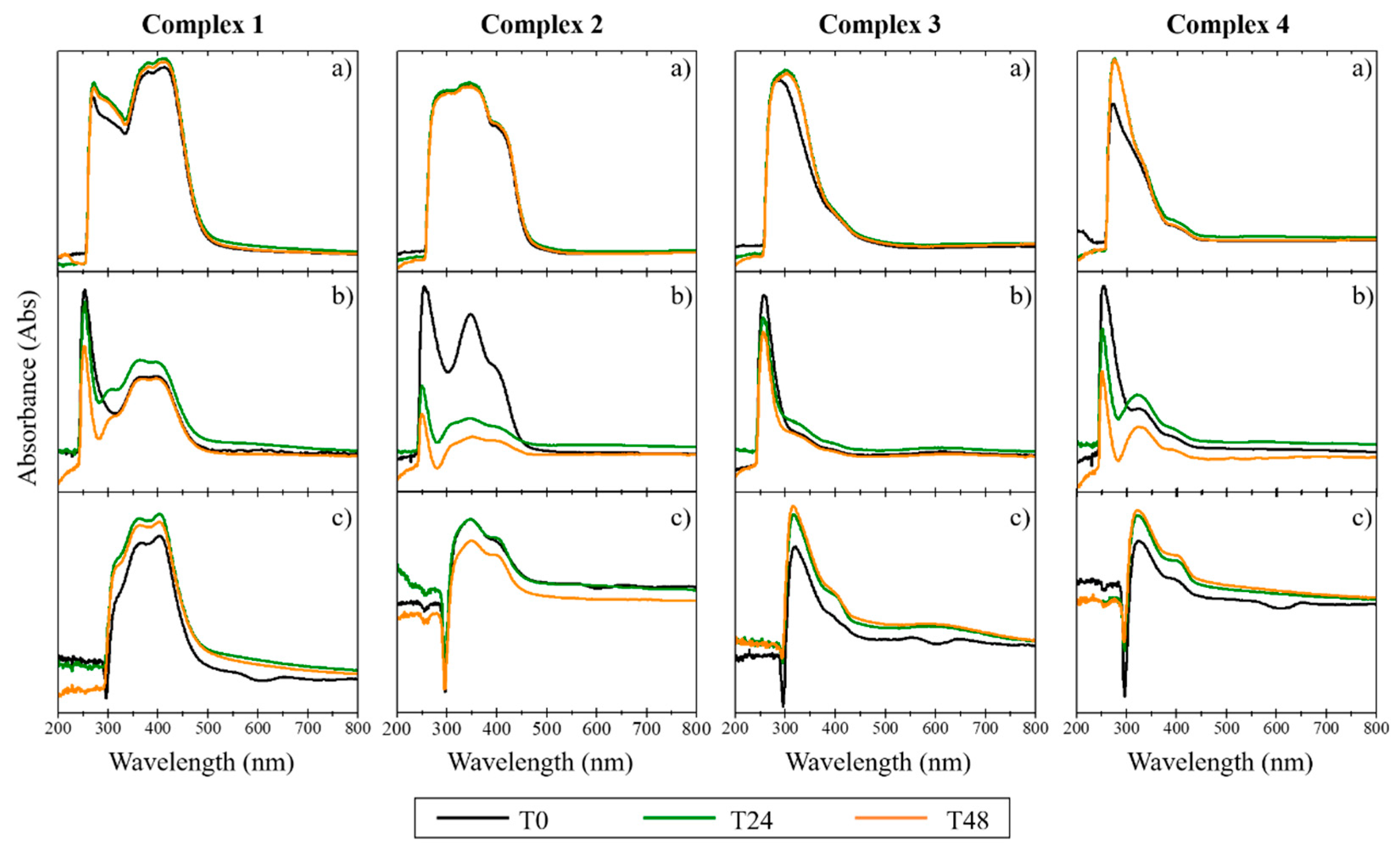

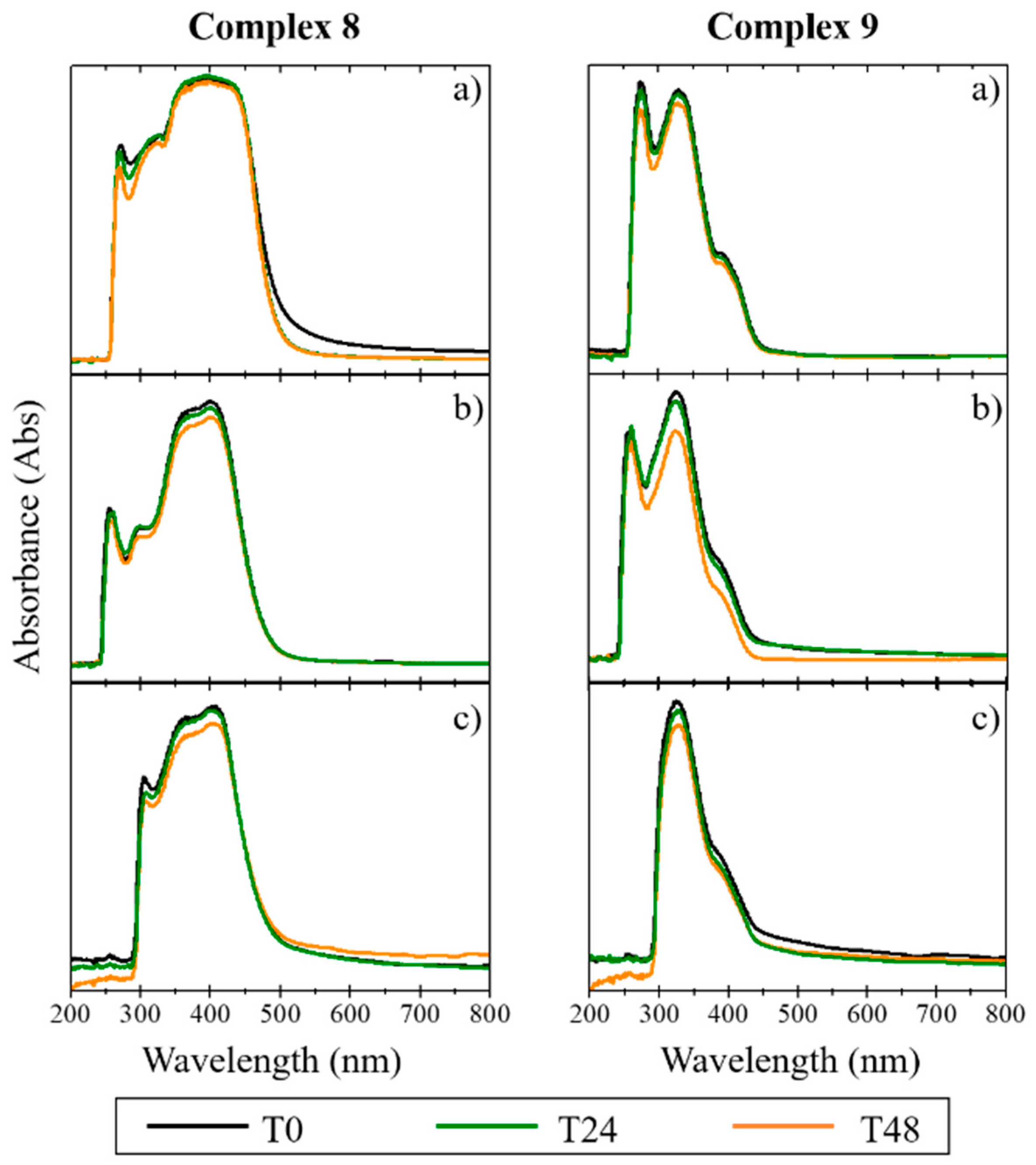
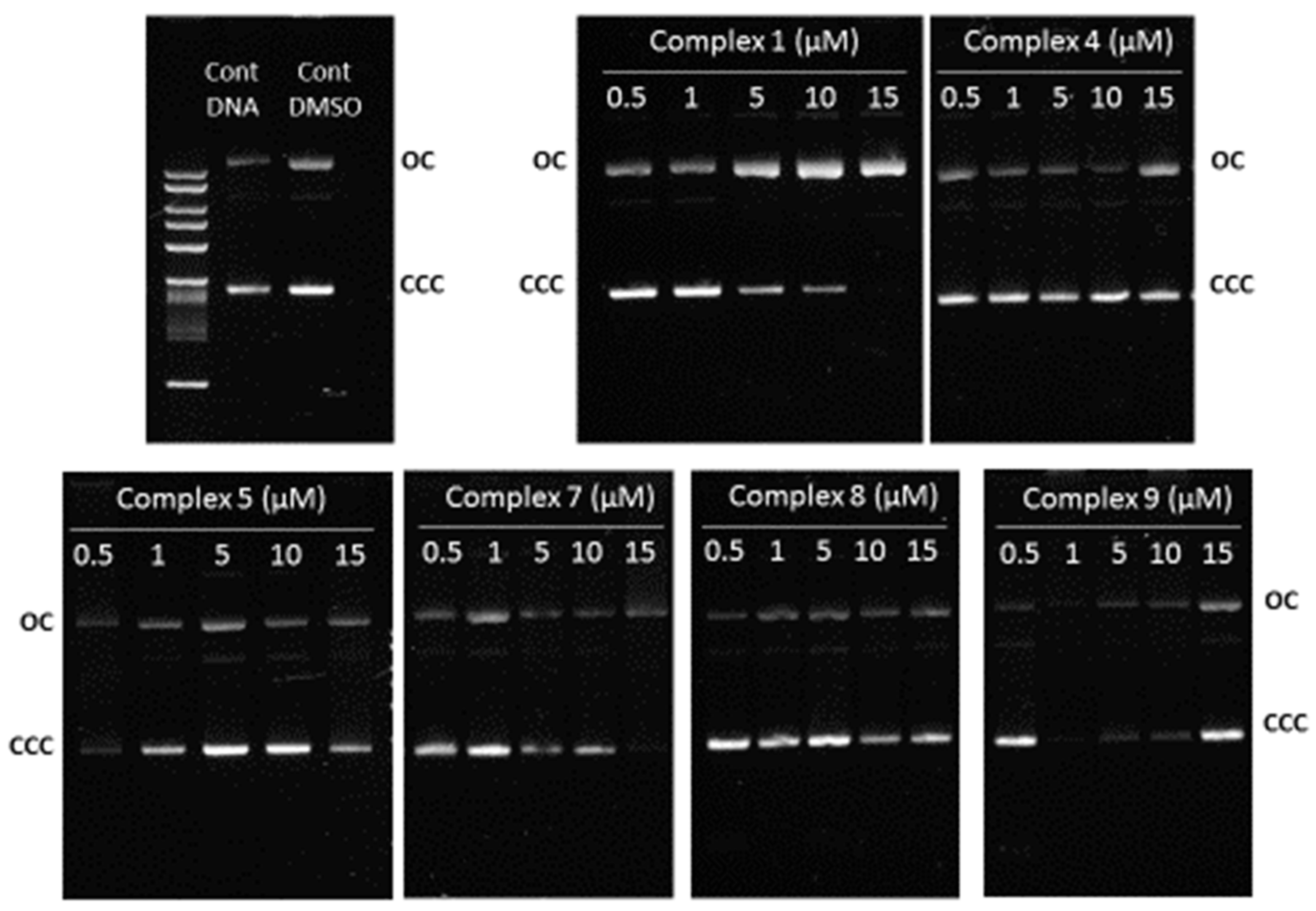
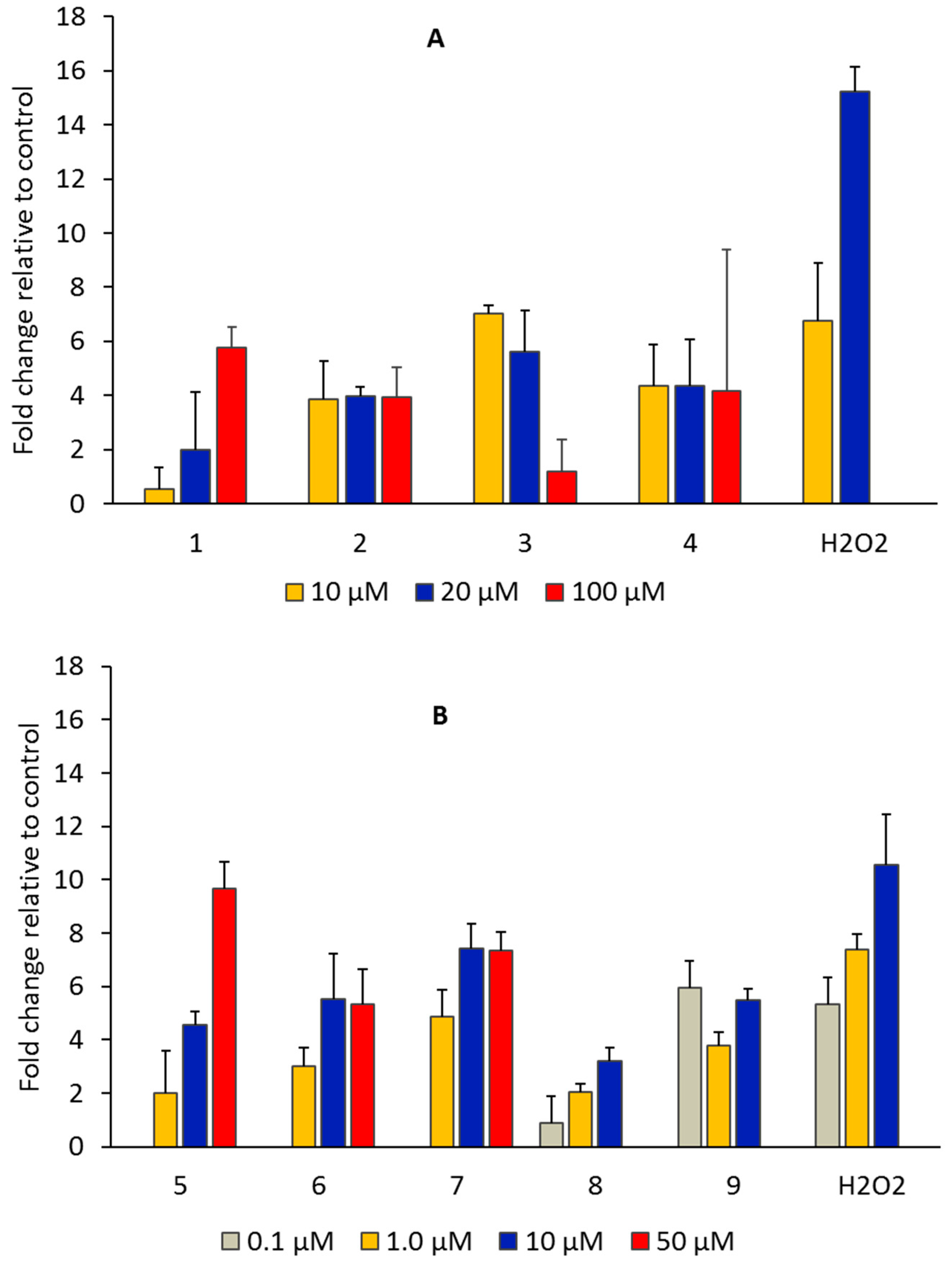
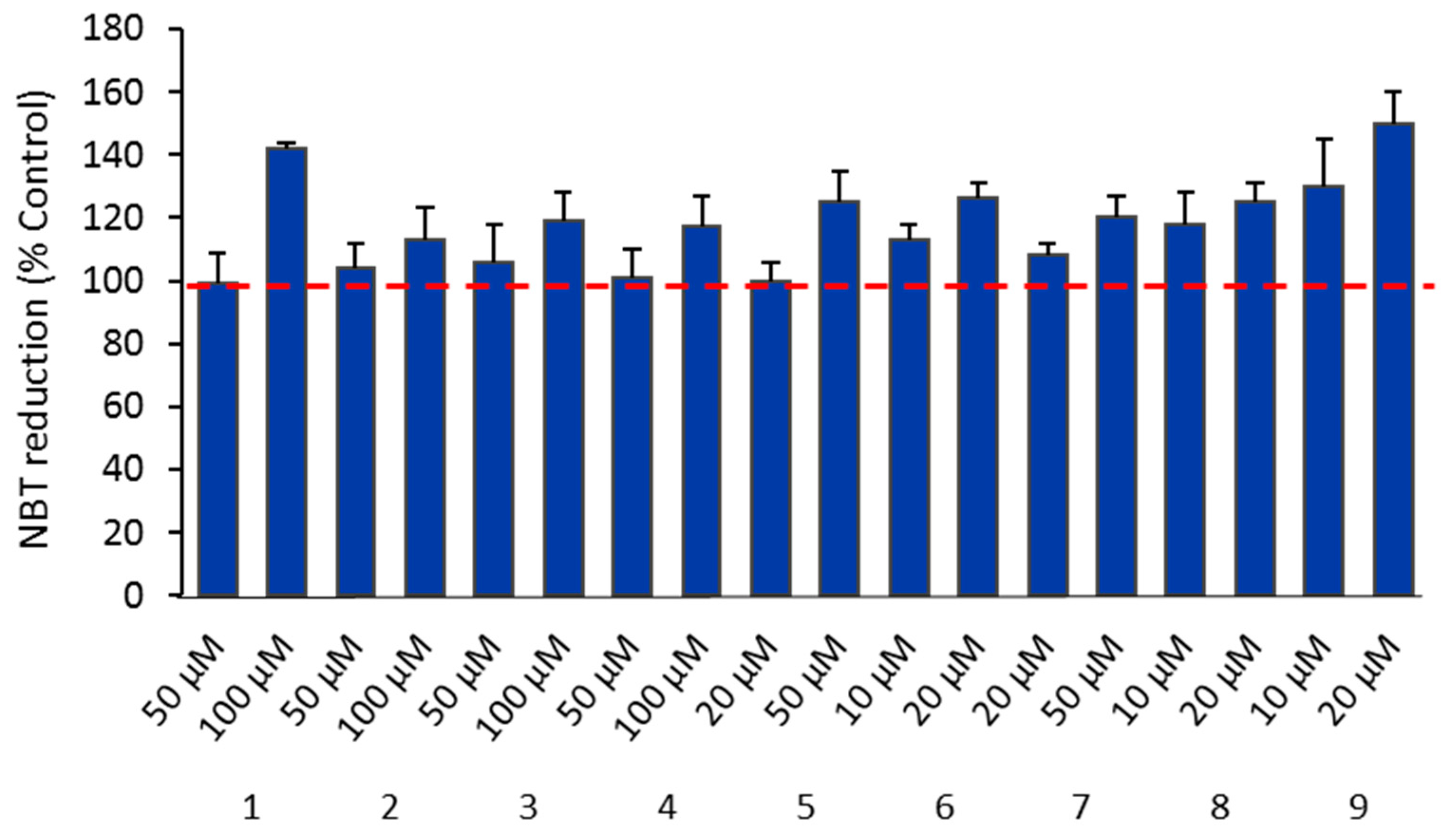
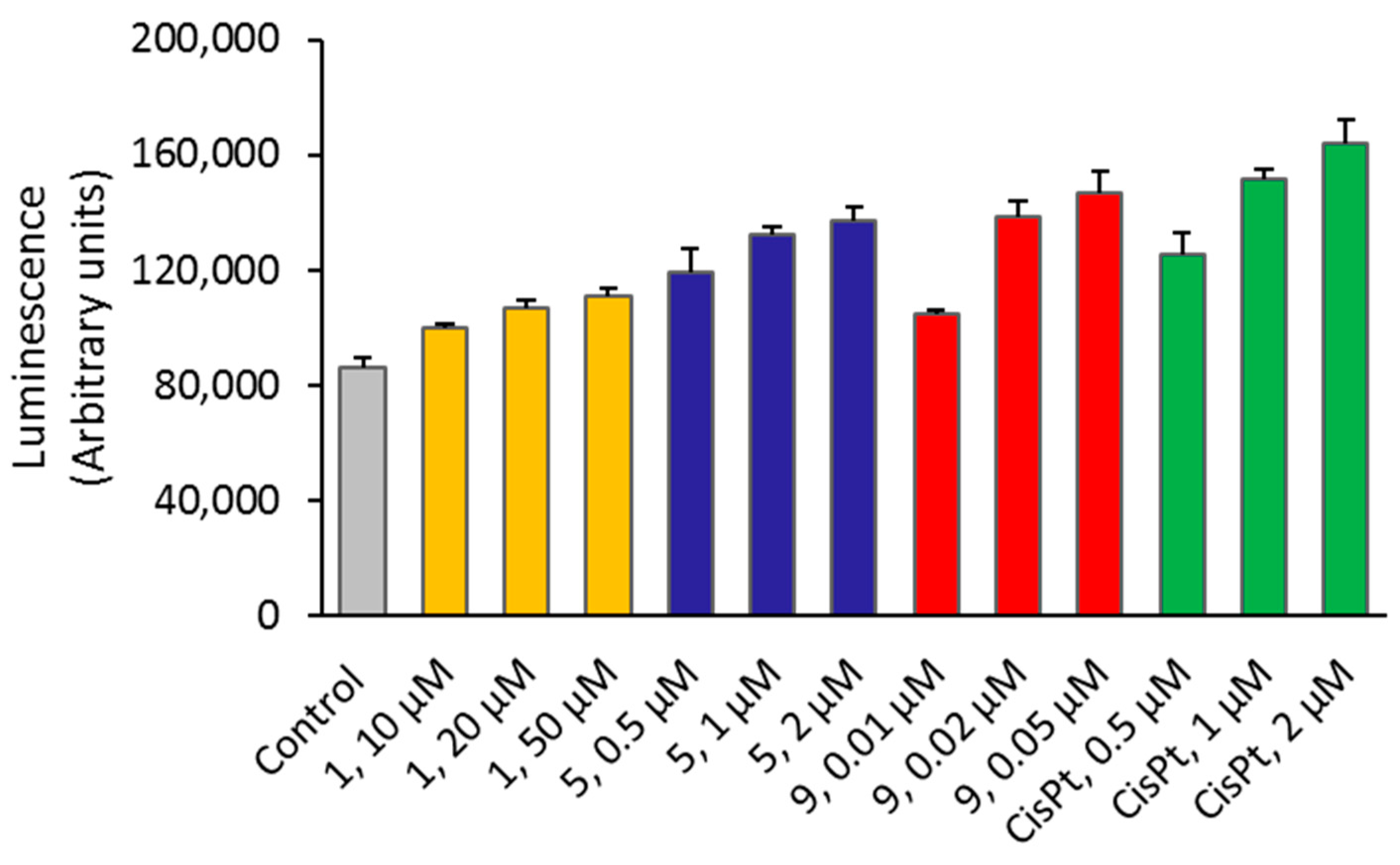
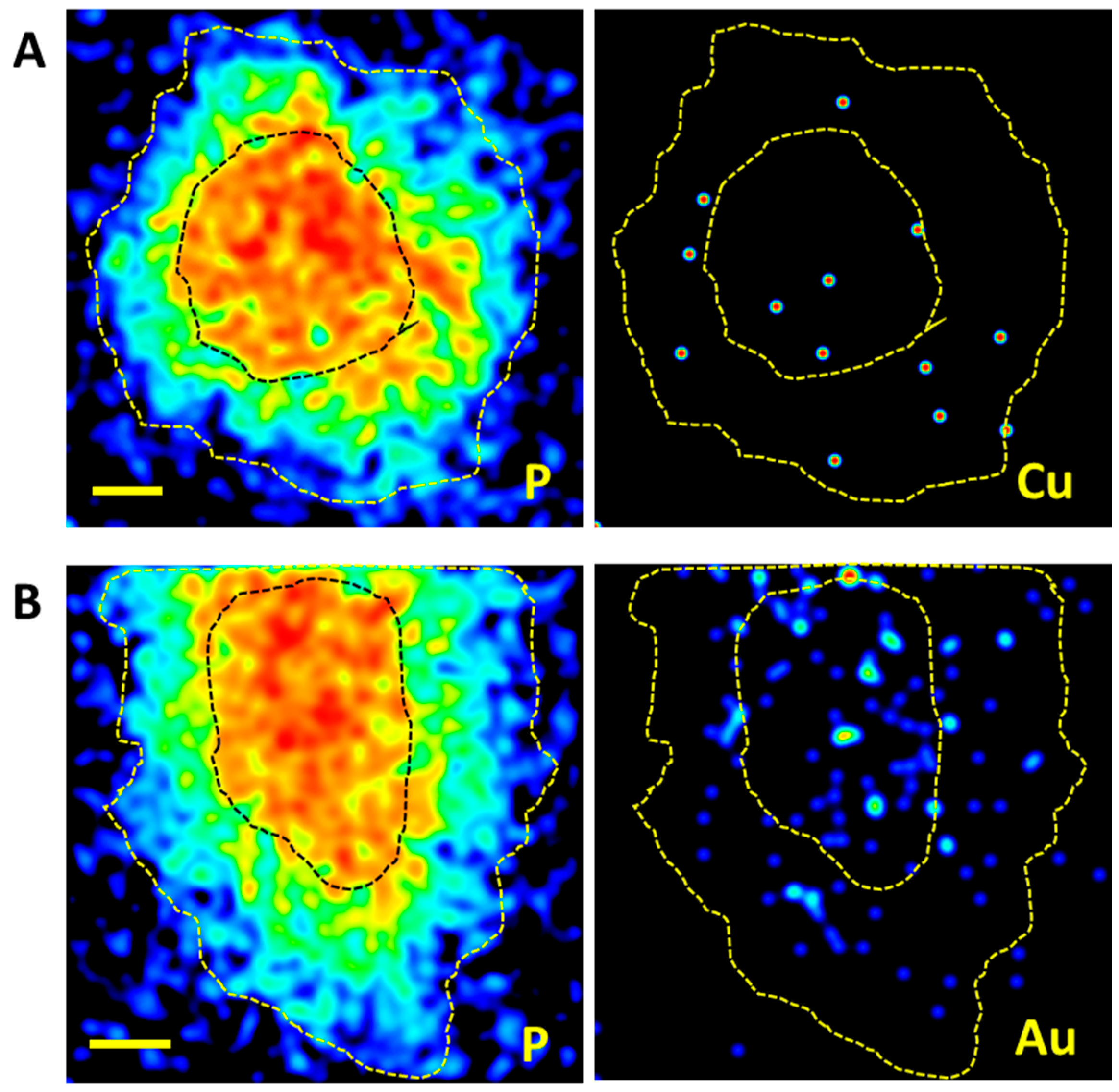
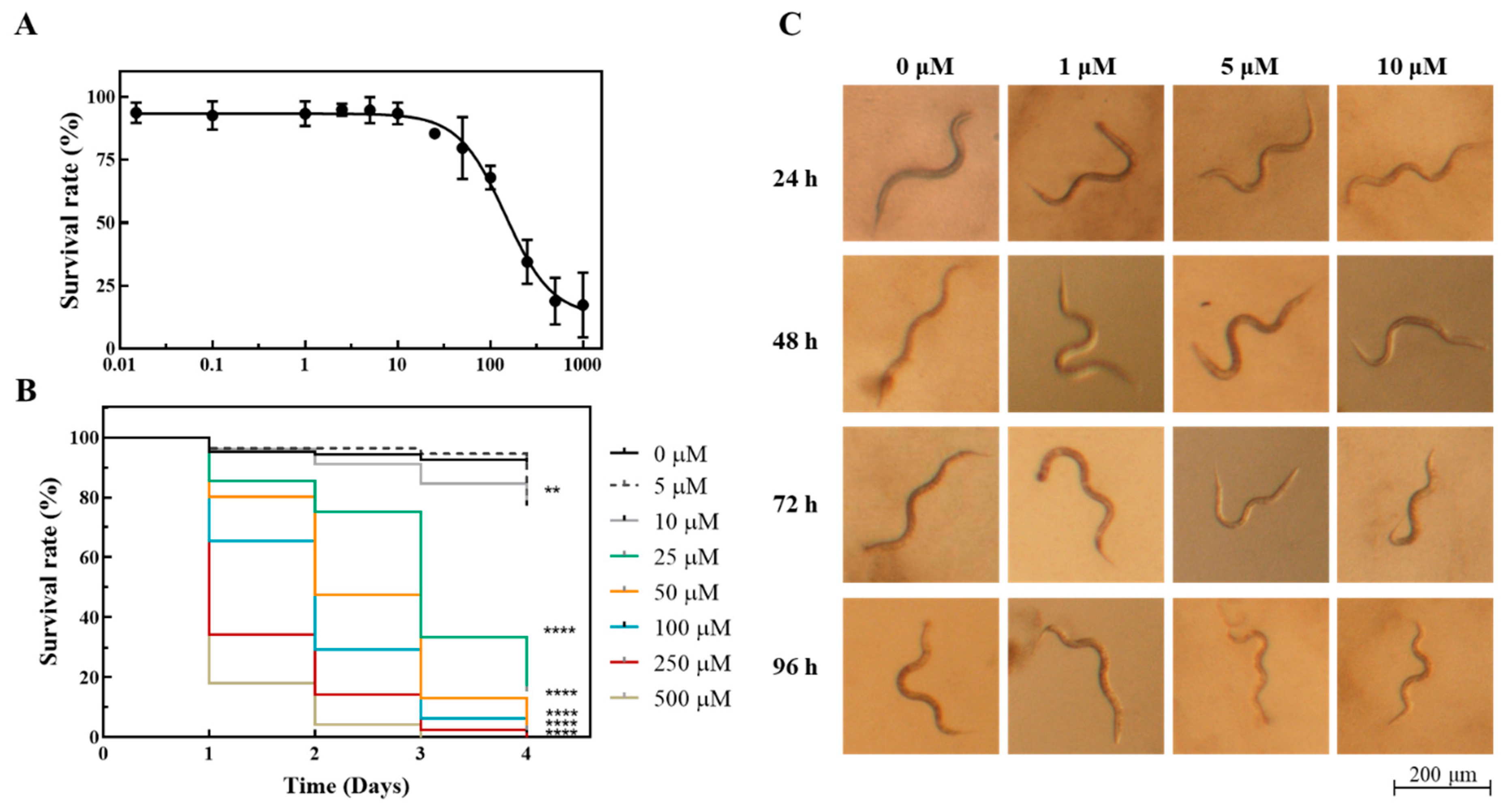
| Complexes | A2780 | OVCAR3 | V79 | HDF | SI c | ||
|---|---|---|---|---|---|---|---|
| [{CuCl}2(2A)] | 1 | −0.49 | 45.6 ± 11 | 72.4 ± 9.1 | 34.5 ± 9.7 | 116 ± 27 | 1.6 |
| [CuCl2(1B)]·2H2O | 2 | 0.48 d | 49.5 ± 14 | 37.6 ± 8.5 | >100 | >100 | >3 |
| [(CuCl)3(2B)] | 3 | −0.46 d | 43.1 ± 9.1 | 37.5 ± 7.7 | 44.9 ± 10 | 48.3 ± 27 | 1.3 |
| [CuCl2(1A)]·HCl·½H2O | 4 | 0.47 d | >100 | 115 ± 25 | >100 | >100 | >1 |
| CuCl | −0.46 | >100 | |||||
| CuCl2 | 0.58 d | >100 | |||||
| [Ag(NO3)(1A)2] | 5 | 0.12 | 3.53 ± 0.90 | 2.24 ± 0.48 | >100 | >100 | >50 |
| [{Ag(1A)}2(μ-O)] | 6 | 0.00 | 0.66 ± 0.28 | 0.63 ± 0.23 | 3.01 ± 0.9 | 30.6 ± 8.5 | 49 |
| [Ag(OH)(2A)]CH3COOH | 7 | −0.047 | 10.4 ± 2.9 | 8.99 ± 3.3 | 34.1 ± 15 | >100 | 31 |
| Ag(NO3) | 0.18 | 2.66 ± 1.0 | |||||
| Ag(CH3COO) | −0.043 | 3.38 ± 2.0 | |||||
| K2[{Au(CN)2}2(1A)3]·½H2O | 8 | −1.65 | 0.08 ± 0.01 | 0.08 ± 0.03 | 0.48 ± 0.06 | 0.46 ± 0.17 | 5.7 |
| K[Au(CN)2(2A)]·H2O | 9 | −1.85 | 0.04 ± 0.02 | 0.07 ± 0.01 | 0.48 ± 0.30 | 0.59 ± 0.11 | 8.4 |
| KAu(CN)2 | 0.49 ± 0.02 |
| Complexes | MDA (pmoles/106 Cells) |
|---|---|
| 1 | 290 ± 15 |
| 5 | 1740 ± 270 |
| 9 | 1370 ± 210 |
| Control | 7 ± 4 |
| Complex | Metal | Concentration (ng Metal Content/106 Cells) |
|---|---|---|
| 1 | Cu | 54 ± 4 |
| 5 | Ag | 273 ± 15 |
| 9 | Au | 688 ± 23 |
Publisher’s Note: MDPI stays neutral with regard to jurisdictional claims in published maps and institutional affiliations. |
© 2022 by the authors. Licensee MDPI, Basel, Switzerland. This article is an open access article distributed under the terms and conditions of the Creative Commons Attribution (CC BY) license (https://creativecommons.org/licenses/by/4.0/).
Share and Cite
Costa, J.P.; Pinheiro, T.; Martins, M.S.; Carvalho, M.F.N.N.; Feliciano, J.R.; Leitão, J.H.; Silva, R.A.L.; Guerreiro, J.F.; Alves, L.M.C.; Custódio, I.; et al. Tuning the Biological Activity of Camphorimine Complexes through Metal Selection. Antibiotics 2022, 11, 1010. https://doi.org/10.3390/antibiotics11081010
Costa JP, Pinheiro T, Martins MS, Carvalho MFNN, Feliciano JR, Leitão JH, Silva RAL, Guerreiro JF, Alves LMC, Custódio I, et al. Tuning the Biological Activity of Camphorimine Complexes through Metal Selection. Antibiotics. 2022; 11(8):1010. https://doi.org/10.3390/antibiotics11081010
Chicago/Turabian StyleCosta, Joana P., Teresa Pinheiro, Maria S. Martins, M. Fernanda N. N. Carvalho, Joana R. Feliciano, Jorge H. Leitão, Rafaela A. L. Silva, Joana F. Guerreiro, Luís M. C. Alves, Inês Custódio, and et al. 2022. "Tuning the Biological Activity of Camphorimine Complexes through Metal Selection" Antibiotics 11, no. 8: 1010. https://doi.org/10.3390/antibiotics11081010
APA StyleCosta, J. P., Pinheiro, T., Martins, M. S., Carvalho, M. F. N. N., Feliciano, J. R., Leitão, J. H., Silva, R. A. L., Guerreiro, J. F., Alves, L. M. C., Custódio, I., Cruz, J., & Marques, F. (2022). Tuning the Biological Activity of Camphorimine Complexes through Metal Selection. Antibiotics, 11(8), 1010. https://doi.org/10.3390/antibiotics11081010









